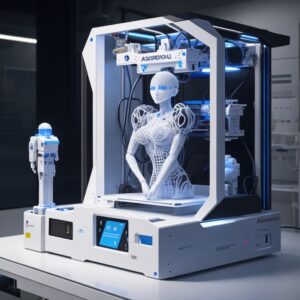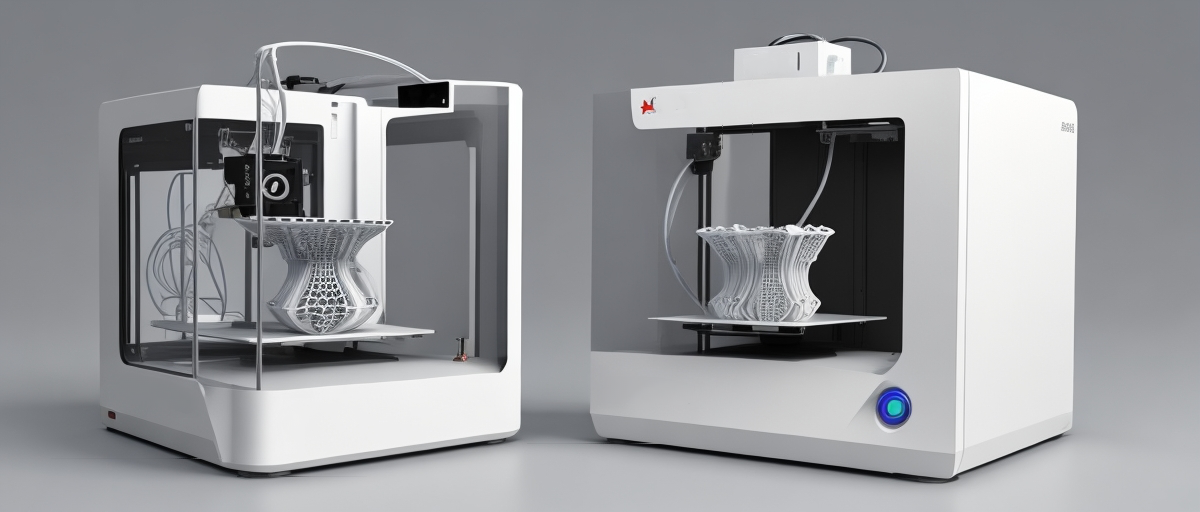Autonomous 3D printing represents a leap from its predecessors in the additive manufacturing domain. Unlike manual or semi-automated printers that require human oversight for tasks like calibration or the changing of materials, autonomous printers boast self-sufficient systems capable of adapting in real-time. These machines adjust parameters, detect and address errors, and manage materials autonomously, even self-regulating their maintenance cycles.
Several current models on the market hint at what’s possible. From desktop versions that autonomously pause when filament runs out to industrial giants equipped with intricate sensor arrays that adjust print parameters, the landscape is rapidly expanding.
Technological Drivers Behind Smart Printers

The technological landscape of 3D printing is being reshaped by the continuous integration of smart features, primarily driven by advancements in artificial intelligence (AI) and machine (ML). These technologies act as the brain behind the operations, analyzing vast amounts of data to deliver predictive insights that optimize print processes. AI algorithms are sophisticated enough to learn from past prints, allowing them to sharpen their decision-making over time, thus improving efficiency and reducing the chance for errors. These algorithms can even simulate prints before they are initiated, foreseeing possible issues and adjusting parameters to preemptively counteract them.
Machine learning plays an important role in this ecosystem, analyzing real-time information to make instant corrective actions for maintaining print quality. It enables a dynamic response system within the printer, where ML models can adjust to variances in material flows or compensate for sudden shifts in the print head’s motion, ensuring that the final product adheres to the strictest standards.
Advances in software development are important in driving the autonomy of smart printers. Recent innovations in slicer algorithms, which convert 3D models into layers ready for printing, have introduced higher precision in the print instructions and adaptive slicing techniques. These smart slicers can adjust the layer height or modify print speeds in different sections of a print, optimizing for time efficiency or surface finish quality as needed.
User interfaces (UI) have also undergone their own revolution. Modern interfaces on smart printers are increasingly intuitive, boasting touchscreen capability, and often harmonized with mobile applications to allow remote printer management. The goal is to simplify the interaction between human operators and the machine, making it possible for individuals with varied levels of expertise to achieve professional-grade results.
The synergy between AI and ML for processing and decision-making, IoT for data collection and environmental awareness, and the continual enhancements in software tools collectively establish the foundation for autonomous 3D printing. They are the technological drivers transforming the industry, turning 3D printers into intelligent manufacturing units capable of self-optimization, adapting to print challenges on-the-fly, and minimizing the need for human interference, which is a cornerstone of the next generation of smart printers.
Benefits of Autonomous 3D Printers
The advent of autonomous 3D printers ushers in a new era where the precision and repeatability once reserved for high-end manufacturing facilities become accessible to the wider public. It’s a significant leap democratizing the fabrication process, as these intelligent machines level the playing field between industry giants and smaller-scale makers. With minimal input, users can consistently produce parts and products that meet exacting standards, ensuring quality remains unhindered by human error.
For professionals, the implications are profound. Architects can swiftly prototype new building designs, dentists can produce dental appliances on-site, and educators can model complex scientific concepts with the push of a button. Novice users benefit from simplified operation procedures, making advanced manufacturing methodologies a reality in classrooms, home offices, and small businesses without the requirement for extensive training.
Efficiency is another arena in which autonomous 3D printers excel. Through the use of smart systems, these machines are adept at optimizing material consumption, leading to less waste and a reduction in overall production costs. Given their ability to control material deposition, they support sustainability efforts by consuming only what is necessary for each print. This eco-friendly approach appeals to environmentally conscious consumers and aligns with the larger goals of responsible industry practices.
In the world of business, the scalable nature of autonomous 3D printers cannot be overstated. Responding to a spike in demand to a new product design, these machines adjust production rates and switch between tasks with ease. Their adaptability is a valuable asset in a competitive marketplace where speed to market and agility can be the difference between success and failure. Manufacturers can respond to consumer needs with bespoke solutions and limited runs without incurring the onerous costs typically associated with traditional manufacturing processes.
Autonomous 3D printers are not static fixtures within a facility. Their connection to the cloud and integration within broader digital manufacturing systems allow for new possibilities in decentralized production. Companies can distribute designs digitally to printers across different locations, enabling on-the-spot manufacturing that can drastically reduce logistics costs and delivery times.
The Role of Data in Autonomous 3D Printing
In the dynamic ecosystem of autonomous 3D printing, data plays a critical role that extends beyond the mere operation of the printer. It influences every aspect of the machine’s lifecycle, from preemptive maintenance to the consistent output of high-quality prints. By collecting and analyzing large volumes of operational data, autonomous printers can optimize their performance and anticipate the needs of the user. This accumulated data feeds into machine learning algorithms, allowing the printers to improve their performance over time by learning from each completed job and any identified anomalies.
Data collected from sensors within the printer might include information on extruder temperatures, the speed of the print head, ambient environmental conditions, and the precision of the printed layer. For example, if the printer detects a discrepancy in layer adhesion, it could automatically adjust the extruder temperature for subsequent layers to ensure better adhesion without human intervention. In printers equipped with cameras or laser-scanners, real-time imaging can offer visual data that, when compared against the desired output, allows the printer to make micro-adjustments to correct any deviations as they occur.
The power that comes with data-driven operations also brings forth new challenges in cybersecurity. The proprietary designs and printing specifications used by these devices are valuable intellectual property, much sought after by competitors or cybercriminals. If the data were to be compromised, it could result in significant financial losses or a tarnished reputation due to decreased consumer trust.
Secure data channels and encrypted communications must be in place to protect data as it moves between the printer, cloud storage, and end-users. Maintenance of data integrity ensures that the designs are printed to specifications without tampering. It also includes protection against ransomware or other malicious attacks that could exploit connected printers, bringing production to a halt.
Operational integrity is paramount. This pertains to the protection of data and to the assured consistency of printer performance. Data analytics and predictive maintenance systems rely on the uninterrupted and reliable flow of accurate data to forecast wear and potential failures, planning service schedules effectively, thereby avoiding unexpected downtimes.
The role of data within autonomous 3D printing is multifaceted, enhancing the machine’s intelligence and efficiency while also posing a risk if not adequately protected. As such, striking a balance between leveraging data for improved functionality and safeguarding it against breaches is critical. This balance allows for a seamless and secure operation that lives up to the promise of next-generation autonomous 3D printing — smart, efficient, and reliable.

